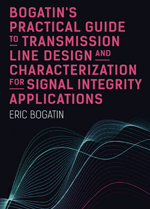 I often get asked by young engineers what it takes to become a good SI/PI or EMC engineer. I quickly respond with, “What’s on your bookshelf?”, because I’m a firm believer you can never learn too much on a particular subject. So answering the same question about myself, I would say, “A lot of books by Dr. Eric Bogatin”.
I often get asked by young engineers what it takes to become a good SI/PI or EMC engineer. I quickly respond with, “What’s on your bookshelf?”, because I’m a firm believer you can never learn too much on a particular subject. So answering the same question about myself, I would say, “A lot of books by Dr. Eric Bogatin”.
You might ask, “Why so many of his books?”. The reason is Eric always has something new to teach me. Especially with one of his latest books, "Bogatin’s Practical Guide to Transmission Line Design and Characterization for Signal Integrity Applications." The 603 page book is available in two formats, e-book and hard cover print. Both versions are available through Artech House.
I started with the e-book version, but later got the hard cover book because I’m old school and like to have hard copy books on my bookshelf as a quick reference. If you are trying to decide which version to buy, I recommend the e-book. You see, Eric has trailblazed the industry, once again, with this version. If you have been following Eric’s teachings through his webinars and videos, you would now have the best of both worlds on your hard drive.
In the first chapter, Eric asks the question, “Do we really need another transmission line book?”, then goes onto explain his reasoning behind why we do. I would, however, ask another question: “Do we really need a different transmission line book?” Here’s why.
The e-book is multimedia. Eric has cleverly integrated video tutorials to reinforce the written text to further cement his teachings. By clicking on embedded hyperlinks to a secure website, you get to watch a short video related topic. It is like having Eric as your own personal virtual tutor you can watch over and over to strengthen the concepts he has described in the text.
The internet is full of content dealing with transmission lines. Much of the content you read is full of complex math equations and confusing explanations that have often been copied and filtered from other blog sites and articles for marketing clickbait. Some of it is just plain wrong or misinterpreted by the author. This just leads to more fear, uncertainty, and doubt (FUD).
Instead, Eric Bogatin’s book starts with basic fundamentals of transmission lines explained and filled with practical examples and videos. At the end of each chapter, there are review questions, and the answers can be found in the Appendix. By the end of the book, you will come away with an understanding of:
- lossless vs lossy transmission lines
- the difference between instantaneous impedance; input impedance; odd/even mode impedance; and characteristic impedance
- microstrip vs stripline geometry and what are the first and second order effects on impedance
- single-ended vs differential transmission lines
- reflections when instantaneous impedance changes
- terminating transmission line circuits
- the physics of crosstalk and mitigation techniques
- return and displacement currents and their roles in transmission lines
- what every scope user needs to know about transmission linesand more……
Furthermore, Eric also blends in actual practical time domain reflectometry (TDR) measurement experiments as well as SPICE circuit models with open sourced Quite Universal Circuit Simulator (QUCS) software. He provides links to the software and most importantly, he provides the actual QUCS circuit files he used in his video tutorials so you can play around with them yourself. This greatly accelerates your learning curve.
As a signal integrity practitioner, I’m used to thinking about and analyzing transmission lines in the time domain. One of the things I finally understood by reading the book is how to analyze transmission lines in the frequency domain. That’s when I experienced an "ah-ha" moment and realized that I could simply determine the characteristic impedance of a transmission line if I followed the 2-port shunt VNA measurement technique, popular in the PI world.
I’m sure you could scour the internet and search for similar content, but why would you want to, when everything you practically wanted to know about transmission lines, you can get in one reference book? It has something for everyone, whether a young engineer starting out, or seasoned gray-hairs like me. I wish I had this book 25 years ago, when I began my journey with signal integrity.
So to answer Eric’s original question, “Do we really need another transmission line book?” Well, after reading the book, I would confidently say, “Yes!”
